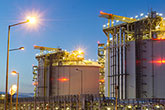Natural gas storage injections remain low
Published by Oliver Kleinschmidt,
Deputy Editor
Tanks and Terminals,
Injections into natural gas storage in the lower 48 states since 1 April have totalled 950 billion ft3, according to the US Energy Information Administration (EIA) 18 July Weekly Natural Gas Storage Report.
So far this injection season (1 April – 31 October), the amount of natural gas injected into storage (less withdrawals) is 15% (166 billion ft3) less than the previous five-year average (2019 – 2023) for the same period and 15% (172 billion ft3) less than the same time in 2023.
Despite the decrease in injections, working natural gas inventories in the Lower 48 states remain relatively high following the warmest winter on record. Natural gas in US storage totalled 3209 billion ft3 as of 12 July, 17% (465 billion ft3) more than the five-year average and 8% (250 billion ft3) above 2023 for the same report week.
Production of natural gas in the US during the second quarter was similar to 2023 during the same period. But US natural gas consumption was 3% (3 billion ft3/d) more, largely driven by increased consumption in the electric power sector, according to our July Short-Term Energy Outlook (STEO).
In EIA’s July STEO, it expects natural gas injections for the remainder of the injection season (July – October) will be 27% (265 billion ft3) less than the five-year average, narrowing the surplus in inventory to 6% above the five-year average by the end of the injection season.
Read the article online at: https://www.tanksterminals.com/terminals/26072024/natural-gas-storage-injections-remain-low/
You might also like
Hydrocarbon Engineering Podcast
Peter Davidson, CEO of the Tank Storage Association (TSA), joins us to discuss the essential role that the tank storage sector has to play in ensuring supply security and resilience, as well as in facilitating the energy transition.
LBC secure subsidy to develop terminal
LBC Vlissingen has been awarded a €6.6 million subsidy to further develop its terminal in Zeeland, the Netherlands.


